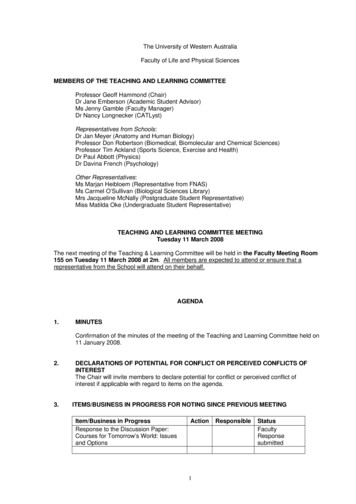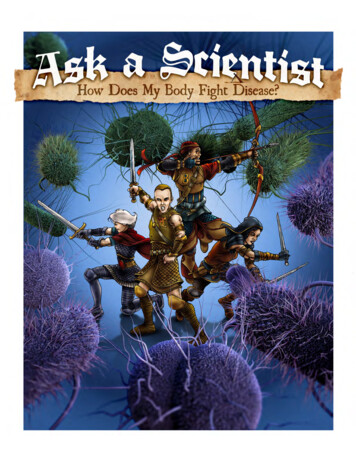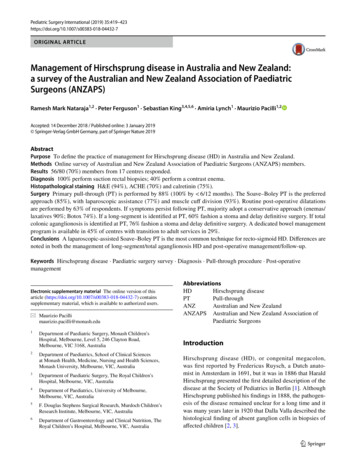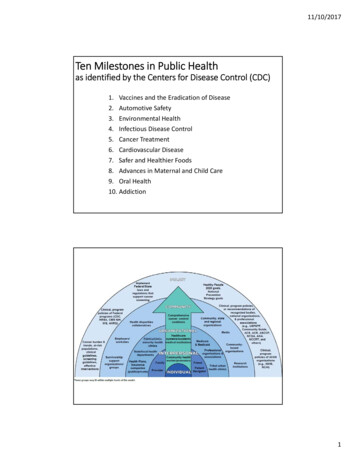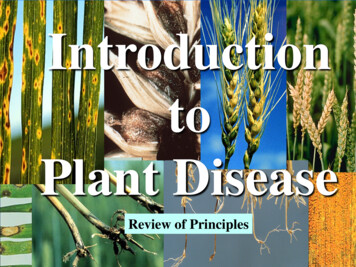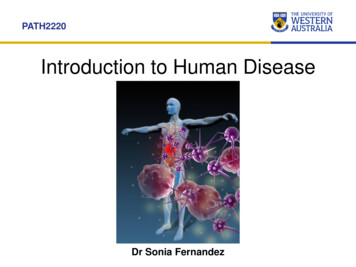
Transcription
PATH2220Introduction to Human DiseaseDr Sonia Fernandez
Contact DetailsUnit website URL:http://www.lms.uwa.edu.auUnit coordinator:Dr Sonia 4 0223Location:2nd floor MRF Building, near RPHConsultation hours:By appointmentUnit deputy coordinator:Dr Ben ocation:Anatomical Pathology, PathWest, FSHConsultation hours:By appointment
Unit Overview Provides a broad understanding of human diseaseprocesses Divided into 1 or 2 week modules– Pathological process “disease mechanism”– Examples of human diseases Level 2 unit – will provide broad coverage of majordisease processes with a greater depth of knowledgeprovided in Level 3 units A “showcase” of pathology aiming to:– Give a broad understanding of human disease processes– Illustrate pathological processes with examples of diseasesresulting from these pathological processes
Unit OutlineWeek No.Module1Introduction2Inflammation3Immunity and disease4Lifestyle and disease5Blood vessels and disease6Blood and blood disorders7Neoplasia 18Forensic Pathology & Mid Sem Test9Neoplasia 210Environment and disease11Infection and disease12Genetics and disease13Research and course review
What is Pathology? Pathology– The scientific study of disease (patterns, causes,mechanisms and effects) Disease:– A condition in which the normal function (homeostasis)of some part or organ of the body is disturbed– A condition of the organism which limits its life ineither its powers, enjoyment or duration (WHO)
What is Pathology? Link between basic biological sciences and clinical tryGenetics
Week 1: Introduction Essential for one or more of diagnosis,prognostication, treatment Education necessary to understand:– nature of disease mechanisms– derangements of normal anatomy,physiology, and biochemistry– how the above relate to manifestationsseen in patient Scientific research– Cellular and molecular basis of disease– Foundation upon which modern medicineis based Introduction to ePractical resourcesand cell/tissue collection & processing
Week 2: Inflammation Inflammatory process Cells Tissues Clinical examples
Week 3: Immunology & disease Normal immunity Overactive vs underactive Allergy Autoimmunity Immunodeficiency
Week 4: Lifestyle & disease Nutrition Diabetes Alcohol Iron metabolism
Week 5: Blood vessels & disease The heart & blood vessels Bleeding & Clotting Heart attack Stroke “Economy class syndrome”
Week 6: Blood & blood disorders Haematology Anaemia Leukocyte disorders Leukaemia Transfusion
Weeks 7 & 9: Neoplasia (cancer) What causes cancer Types of cancer Cancer genetics How we diagnose cancer How cancer spreads Colon, Cervix, Lung, Skin Breast cancer Leukaemia
Week 8: Forensic pathology What is forensic pathology? Natural disease Cause of unexplained orviolent deaths TraumaNote: The Mid-Semester Testis scheduled for this week inplace of an e-learning prac
Week 10: Environment & disease Environmental agents and disease Smoking Radiation Asbestos
Week 11: Infection & disease Infection and disease How we diagnose infections– Bacterial– Viral Tuberculosis Malaria
Week 12: Genetics & disease Principles– Autosomal vs X-linked– Dominant vs recessive Methods Management Haemophilia Thalassaemia Cystic fibrosis
Week 13: Research & Course Review Translating pathology topractice Clinical pathology research All disciplines Biology, treatment,prognosis, monitoring Importance of pathology inunderstanding humandisease
Teaching programme: lecturesDayTimeVenueMonday10:00 – 10:45(Mechanism)FJ Clark Lecture Theatre,Queen Elizabeth II Medical CentreTuesday10:00 – 10:45(Disease 1)FJ Clark Lecture Theatre,Queen Elizabeth II Medical CentreTuesday11:00 – 11:45(Disease 2)FJ Clark Lecture Theatre,Queen Elizabeth II Medical Centre
Teaching programme: ePracticalsDayTimeVenueThursday09:00 – 10:45eLearning Suites Ground Floor, M BlockQueen Elizabeth II Medical CentreFriday09:00 – 10:45eLearning SuitesGround Floor, M BlockQueen Elizabeth II Medical Centre
eLearning Suites
ePracticals Attend Thursday or Friday Interactive sessions using clinical cases to illustratepathology of human disease Macroscopic, microscopic & radiological images Text, on-line resources Worksheets with questions Work in groups of 6 Post-class quizzes: comprise 15% of unit mark– Deadline: Monday 5pm each week
PATH2220 Assessment PATH2220 unit assessment:% of Final Mark– ePractical assessment15%– Written assignment15%– Mid-Semester test20%– Final examination (End of semester):50% Extended matching questions25% Written (short answer) questions25%
Written Assignment 1 written assignment Select an assignment topic from a list All details of requirements in Unit Guidebook Maximum 6 pages Submit via LMS in PDF format Deadline: by 5pm Monday 2nd October 15% of unit mark
Mid Semester Test To see how you are going . Date: Thursday 21st or Friday 22nd September Location: eLearning Suites 1 hour duration Format the same as final exam– Extended Matching Questions (50%)– Short answer questions (50%) 20% of unit mark
End of Semester Exam 2 hour duration Format– Extended Matching Questions (50%)– Short answer questions (50%) 50% of unit mark
Recommended Texts Your main source of information will be the lecture notesand epractical resources provided to you Complementary texts– Pathology at a Glance – C. Finlayson & B. Newell, 1st Ed. 2009.Publisher: Wiley-Blackwell– Immunology at a Glance – J.H.L Playfair and B .M. Chain, 10thEd. Publisher: Wiley-Blackwell– Haematology at a Glance – A. Mehta and V. Hoffbrand, 4th Ed.2013. Publisher: Wiley-Blackwell– Medical Genetics at a Glance – D.J. Pritchard and B.R. Korf, 3rdEd. 2013. Publisher: Wiley-Blackwell
Contact Information Direct your enquiries to the LMS discussion board– I am subscribed so I will see them– Your questions may benefit others Confidential enquiries - email unit coordinator directly– If detailed information is required a phone call or appointmentmay be appropriate Questions about unit content should be directed to theLMS discussion forum Please check the “Announcement” section before sendingan email - your question may have already beenaddressed!
Unit Outline Week No. Module 1 Introduction 2 Inflammation 3 Immunity and disease 4 Lifestyle and disease 5 Blood vessels and disease 6 Blood and blood disorders 7 Neoplasia 1 8 Forensic Pathology & Mid Sem Test 9 Neoplasia 2 10 Environment and disease 11 Infection and dise
